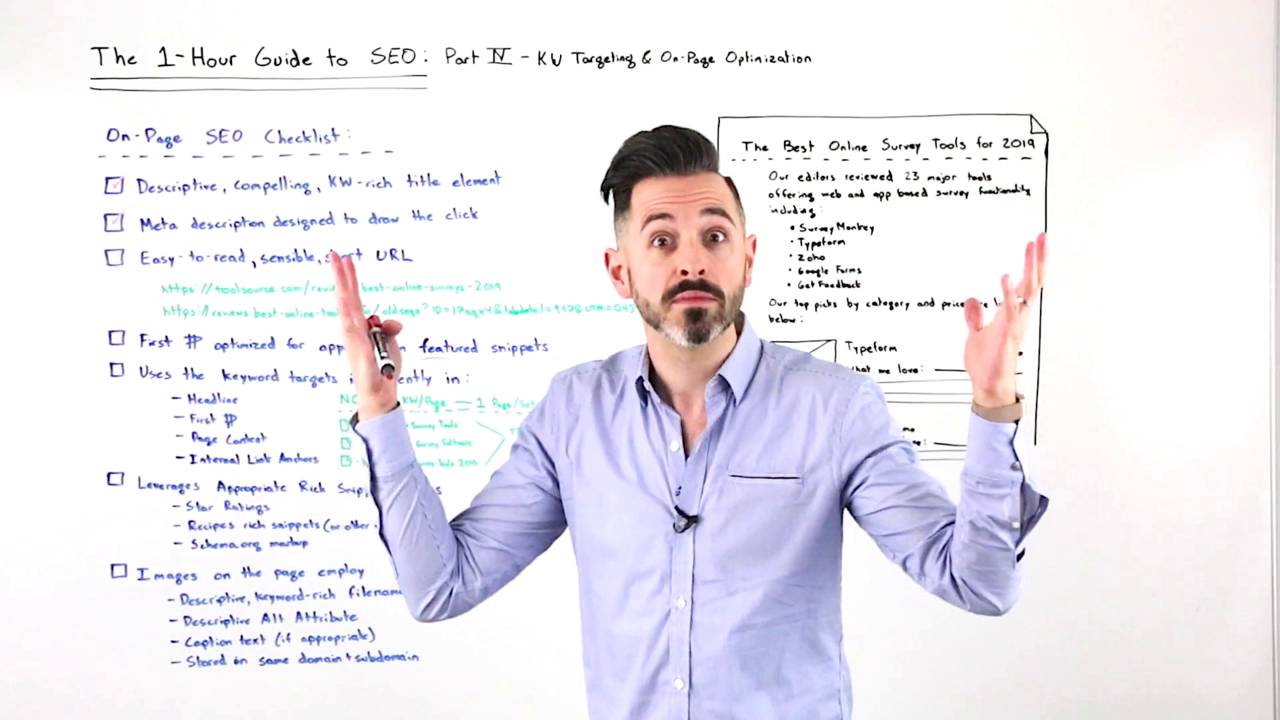In the fourth part of the One-Hour Guide to SEO, Rand offers up an on-page SEO checklist to start you off on your way towards perfectly optimized and keyword-targeted pages. Now how do we make sure that the page is optimal for ranking in Google? By the way, having more than one or two URL parameters is very poorly correlated with and not recommended for trying to rank in search results. That will help Google as well. Sometimes I'll see this box, often with an image and a bunch of descriptive text that's drawn from the page, often from the first paragraph or two. Featured snippet optimization, there's a bunch of resources on Moz's website that we can point you to there too. So if other places on your website talk about online survey tools, you should be linking to this page. If searchers are looking to find exactly the same thing but with slightly modified or slight variations in how they phrase things, you should have a page that serves all of those keywords with that same searcher intent rather than multiple pages that try to break those up, for a bunch of reasons. Schema.org has a full list of these, and Google's rich snippets markup page offers a bunch more. These files, in order to perform well, they generally need to be hosted on the same domain and subdomain.
We’ve covered strategy, keyword research, and how to satisfy searcher intent — now it’s time to tackle optimizing the webpage itself! In the fourth part of the One-Hour Guide to SEO, Rand offers up an on-page SEO checklist to start you off on your way towards perfectly optimized and keyword-targeted pages.
If you missed them, check out the other episodes in the series so far:


Click on the whiteboard image above to open a high resolution version in a new tab!
Video Transcription
Howdy, Moz fans. Welcome to another edition of our special One-Hour Guide to SEO. We are now on Part IV – Keyword Targeting and On-Page Optimization. So hopefully, you’ve watched Part III, where we talked about searcher satisfaction, how to make sure searchers are happy with the page content that you create and the user experience that you build for them, as well as Part II, where we talked about keyword research and how to make sure that you are targeting the right words and phrases that searchers are actually looking for, that you think you can actually rank for, and that actually get real organic click-through rate, because Google’s zero-click searches are rising.

Now we’re into on-page SEO. So this is essentially taking the words and phrases that we know we want to rank for with the content that we know will help searchers accomplish their task. Now how do we make sure that the page is optimal for ranking in Google?
On-page SEO has evolved
Well, this is very different from the way it was years ago. A long time ago, and unfortunately many people still believe this to be true about SEO, it was: How do I stuff my keywords into all the right tags and places on the page? How do I take advantage of things like the meta keywords tag, which hasn’t been used in a decade, maybe two? How do I take advantage of putting all the words and phrases stuffed into my title, my URL, my description, my headline, my H2 through H7 tags, all these kinds of things?
Most of that does not matter, but some of it still does. Some of it is still important, and we need to run through what those are so that you give yourself the best possible chance for ranking.
The on-page SEO checklist
So what I’ve done here is created a sort of brief, on-page SEO checklist. This is not comprehensive, especially on the technical portion, because we’re saving that for Part V, the technical SEO section, which we will get into, of this Guide. In this checklist, some of the most important things are on here.
☑ Descriptive, compelling, keyword-rich title element
Many of the most important things are on here, and those include things like a descriptive, compelling, keyword-rich but not stuffed title element, also called the page title or a title tag. So, for example, if I am a tool website, like toolsource.com — I made that domain name up, I assume it’s registered to somebody — and I want to rank for the “best online survey tools,” well, “The Best Online Survey Tools for 2019” is a great title tag, and it’s very different from best online survey tools, best online survey software, best online survey software 2019. You’ve seen title tags like that. You’ve seen pages that contain stuff like that. That is no longer good SEO practices.
So we want that descriptive, compelling, makes me want to click. Remember that this title is also going to show up in the search results as the title of the snippet that your website appears in.
☑ Meta description designed to draw the click
Second, a meta description. This is still used by search engines, not for rankings though. Sort of think of it like ad text. You are drawing a click, or you’re attempting to draw the click. So what you want to do is have a description that tells people what’s on the page and inspires them, incites them, makes them want to click on your result instead of somebody else’s. That’s your chance to say, “Here’s why we’re valuable and useful.”
☑ Easy-to-read, sensible, short URL
An easy-to-read, sensible, short URL. For example, toolsource.com/reviews/best-online-surveys-2019. Perfect, very legible, very readable. I see that in the results, I…

COMMENTS